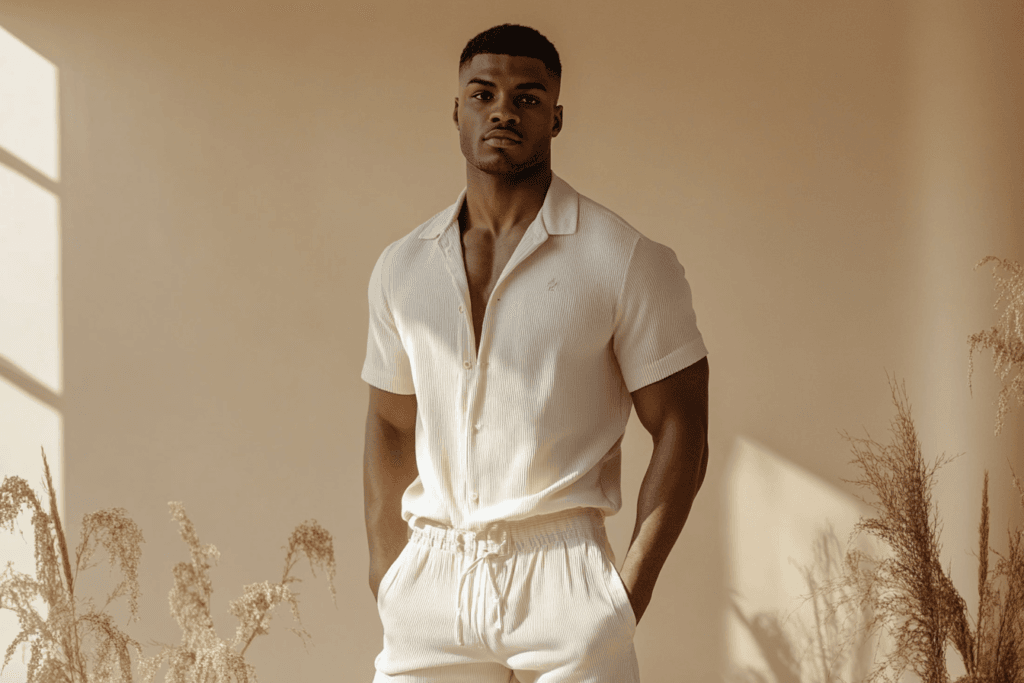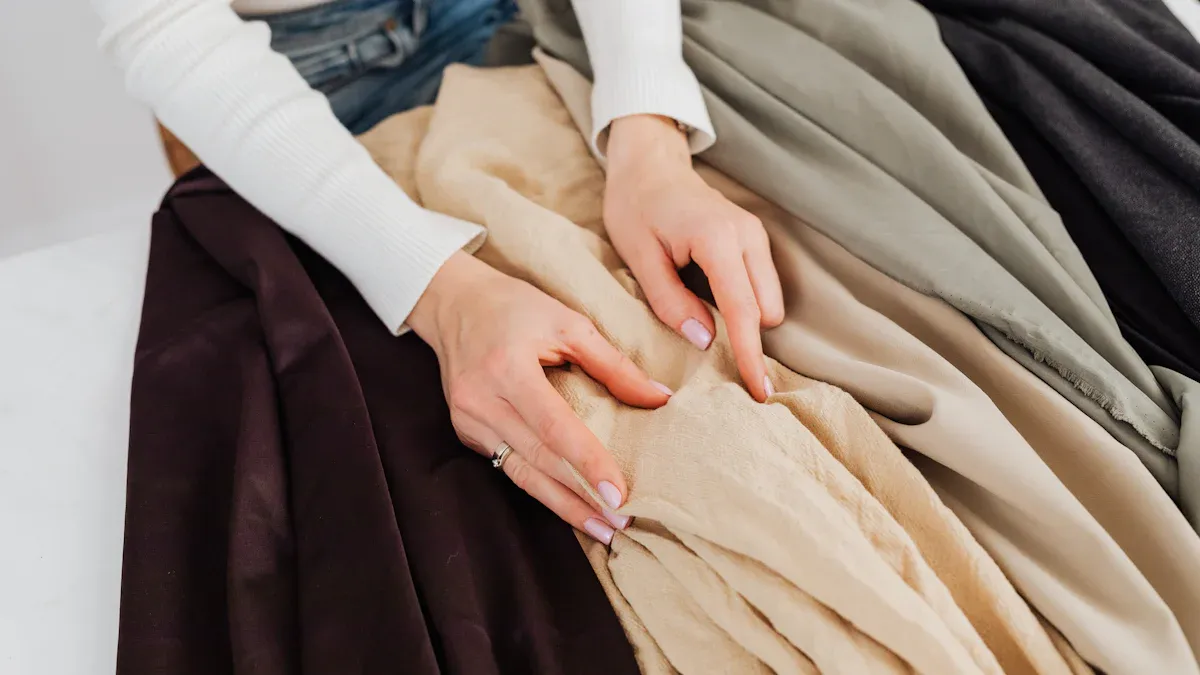
Choosing the right breathable fabric is essential for creating comfortable and functional private label clothing.
Breathable materials allow air to circulate, helping wearers stay cool and dry. Consider factors like durability, texture, and environmental impact as you source fabrics. Evaluate suppliers carefully to ensure consistent quality and ethical practices. Balancing affordability with sustainability can strengthen your brand’s reputation while meeting customer expectations.
By focusing on these aspects, you can deliver high-quality apparel that stands out in the market.
Key Takeaways
- Pick fabrics like cotton and linen for hot weather. These let air flow and soak up sweat.
- Check suppliers closely. Choose ones with good reviews and certifications like OEKO-TEX or GOTS for quality and eco-friendliness.
- Ask for fabric samples and test them first. This will ensure that they are breathable, strong, and work well.
- Keep costs low, but consider the environment. Talk to suppliers for better prices and use eco-friendly options to improve your brand’s image.
- Stay connected with suppliers by talking often and checking quality. This keeps products good and business running smoothly.
What Are the Different Types of Breathable Fabrics Available?

Understanding the different types of breathable fabrics can help you make informed decisions when choosing materials for your private label clothing. Each type offers unique benefits, making it suitable for various clothing styles and purposes.
Natural Fabrics (e.g., cotton, linen, wool)
Natural fabrics are derived from plants or animals, making them a popular choice for breathable clothing. Cotton, for example, is soft, lightweight, and allows air to flow freely. It absorbs moisture, keeping the wearer comfortable in warm weather. Linen, another plant-based fabric, is even more breathable than cotton. Its loose weave and moisture-wicking properties make it ideal for summer wear. Wool, though often associated with warmth, is surprisingly breathable. It regulates temperature by wicking moisture away from the skin, making it suitable for both hot and cold climates.
Natural fabrics are also biodegradable, which aligns with sustainable sourcing practices. However, they may require more care, as they can shrink or wrinkle easily. You should weigh these factors when deciding if natural fabrics fit your brand’s needs.
Synthetic Fabrics (e.g., polyester, nylon)
Synthetic fabrics are man-made materials designed to mimic or enhance the properties of natural fibers. Polyester is one of the most widely used synthetic fabrics due to its durability and moisture-wicking abilities. It dries quickly, making it a favorite for activewear and outdoor clothing. Nylon, another synthetic option, is lightweight and resistant to abrasion. It offers excellent stretch, which improves comfort and fit.
While synthetic fabrics are less breathable than natural ones, advancements in textile technology have improved their performance. Many synthetic materials now feature micro-perforations or moisture-wicking treatments to enhance breathability. These fabrics are also easy to care for and resistant to wrinkles, making them practical for everyday use.
Fabric Blends for Enhanced Breathability
Fabric blends combine natural and synthetic fibers to create materials that balance comfort, durability, and functionality. For example, blending cotton with polyester enhances the fabric’s strength and reduces shrinkage. This combination also improves moisture management, making it suitable for activewear.
Blended fabrics offer several advantages:
| Benefit | Description |
|---|---|
| Improved Strength and Durability | Blending strong synthetic fibers like polyester with natural fibers like cotton enhances durability. |
| Enhanced Comfort | Natural fibers add softness and breathability, while synthetic fibers improve stretch and fit. |
| Better Moisture Management | Blended fabrics can be tailored for specific needs, such as elasticity for a better fit. |
| Wrinkle and Shrink Resistance | Synthetic fibers reduce wrinkling and shrinking, making blended fabrics easier to care for. |
| Versatility | Blended fabrics can be tailored for specific needs, such as elasticity for better fit. |
| Cost-Effective | Blending fibers often reduces production costs, making high-quality fabrics more affordable. |
These blends are versatile and can be customized to meet specific requirements, whether you need elasticity for sportswear or softness for casual clothing. By choosing fabric blends, you can create breathable fabric options that cater to a wide range of customer preferences.
Where Can You Source High-Quality Breathable Fabrics?

Finding the right breathable fabric begins with sourcing from reliable and trustworthy suppliers. This process involves identifying dependable partners, exploring various sourcing platforms, and testing fabric samples to ensure quality and suitability for your private label clothing.
Identifying Reliable Suppliers
Reliable suppliers play a crucial role in ensuring consistent fabric quality. Start by researching suppliers with a proven track record in the textile industry. Look for those who specialize in breathable fabric options, as they are more likely to understand your specific needs. Check online reviews, testimonials, and case studies to evaluate their reputation.
You should also consider suppliers who offer transparency in their processes. Ask about their sourcing methods, production standards, and certifications. Suppliers adhering to industry standards, such as OEKO-TEX or GOTS, often provide higher-quality and sustainable materials. Building a relationship with such suppliers can help you maintain consistent quality in your clothing line.
Exploring Trade Shows and Online Marketplaces
Trade shows and online marketplaces are excellent platforms for sourcing breathable fabrics. Trade shows allow you to interact directly with suppliers, examine fabric samples, and discuss your requirements in person. Events like Texworld or Premiere Vision showcase a wide range of fabric options, including natural, synthetic, and blended materials.
Online marketplaces, on the other hand, offer convenience and accessibility. They allow you to browse fabric options from suppliers worldwide without the need for travel. Some benefits of using online platforms include:
- Global Accessibility and Visibility: You can explore designs and materials anytime, anywhere, reaching international markets effortlessly.
- Cost Efficiency: Online platforms eliminate expenses like booth rentals and travel costs associated with trade shows.
- Broader Audience: These platforms connect you with suppliers across various industries, expanding your sourcing options.
Combining both trade shows and online marketplaces can give you a comprehensive view of available fabrics and help you make informed decisions.
Requesting and Testing Fabric Samples
Before finalizing your choice, request fabric samples from potential suppliers. Testing these samples ensures the material meets your quality standards and aligns with your brand’s requirements. Industry benchmarks for fabric testing include various methods to assess performance, durability, and compliance. Here are some common tests:
| Testing Method | Description |
|---|---|
| Performance Testing | Includes abrasion or piling tests (Martindale, ICI) to assess durability. |
| Dimensional Stability | Evaluates shrinkage, elongation, and stretch recovery. |
| Weather Testing | Tests for waterproof, windproof, and thermal properties. |
| Burn Test | Conducted for 100% cotton textiles to assess flammability. |
| Colorfastness Tests | Checks for colorfastness to water, light, and other elements. |
| Certification | Options for in-house quality marks and adherence to sustainable practices. |
| Regulatory Compliance | Adheres to EU and USA textile standards, including REACH and AATCC tests. |
Testing fabric samples helps you verify their breathability, durability, and overall performance. For example, you can assess how well the fabric wicks moisture or withstands wear and tear. This step ensures that the breathable fabric you choose will meet customer expectations and enhance your brand’s reputation.
How Do You Evaluate a Breathable Fabric Supplier’s Quality?
Ensuring the quality of your breathable fabric starts with evaluating your suppliers. A thorough assessment helps you identify trustworthy partners who can meet your brand’s standards. Here’s how you can evaluate supplier quality effectively.
Key Questions to Ask Suppliers
When speaking with potential suppliers, ask targeted questions to understand their capabilities. Start by inquiring about their experience with breathable fabric. Ask how they source their materials and whether they can provide consistent quality. Request details about their production capacity to ensure they can handle your order volume.
You should also ask about lead times and delivery reliability. Delays can disrupt your production schedule, so it’s important to confirm their ability to meet deadlines. Finally, discuss their policies for handling defective materials. A clear return or replacement policy shows their commitment to quality.
Checking Certifications and Compliance
Certifications provide proof that a supplier meets industry standards. Look for certifications like OEKO-TEX, which ensures fabrics are free from harmful substances, or GOTS, which verifies organic textile production. These certifications indicate that the supplier prioritizes safety and sustainability.
Compliance with local and international regulations is equally important. Check if the supplier adheres to standards like REACH in Europe or AATCC in the United States. These regulations ensure the fabric meets safety and environmental requirements. Always request documentation to verify compliance.
Conducting Quality Assessments
Testing fabric quality is a critical step before finalizing a supplier. Request samples and perform tests to evaluate the fabric’s performance. Check for breathability, durability, and moisture-wicking properties. Use simple tests, like stretching the fabric to assess elasticity or holding it up to light to examine its weave.
You can also conduct lab tests for more detailed results. For example, test for colorfastness to ensure the fabric won’t fade after washing. These assessments help you confirm that the supplier’s materials align with your brand’s standards.
Tip: Keep detailed records of your evaluations. This will help you compare suppliers and make informed decisions.
Can You Balance Affordability and Sustainability in Breathable Fabrics?
Balancing cost and sustainability is essential when sourcing breathable fabrics for your private label clothing. By understanding cost factors, negotiating effectively, and prioritizing sustainable practices, you can achieve a balance that benefits both your brand and the environment.
Understanding Cost Factors in Breathable Fabrics
The cost of breathable fabric depends on several factors, including material type, production methods, and technological advancements. Natural fabrics like cotton or linen often cost more due to their farming and harvesting processes. Synthetic options, such as polyester, are typically more affordable but may require additional treatments to enhance breathability.
Recent market analysis shows that technological advancements are improving fabric breathability, durability, and sustainability while reducing manufacturing costs. This progress allows you to source high-quality materials without exceeding your budget. Additionally, the growing demand for eco-friendly textiles has led to more competitive pricing in sustainable options. Understanding these trends can help you make informed decisions about your fabric choices.
Negotiating with Suppliers
Negotiation is a key step in managing costs. Start by discussing bulk discounts, as larger orders often reduce the price per unit. Ask suppliers about alternative materials or blends that offer similar performance at a lower cost. For example, a cotton-polyester blend might provide the breathability you need while being more affordable than 100% cotton.
You should also negotiate payment terms. Flexible options, such as extended payment periods, can ease cash flow challenges. Building a strong relationship with your supplier can lead to better deals and long-term savings. Always approach negotiations with clear goals and a willingness to compromise.
Prioritizing Sustainable Sourcing Practices
Sustainability is becoming a critical factor in the textile industry. Consumers increasingly value transparency in supply chains and prefer brands that use eco-friendly materials. This shift has led to a rise in conscious consumption and demand for locally made products. By prioritizing sustainable sourcing, you can align your brand with these values and attract environmentally conscious customers.
Focus on suppliers who use renewable resources and minimize waste during production. Certifications like GOTS or OEKO-TEX can help you identify suppliers committed to sustainability. Additionally, consider the environmental impact of transportation. Sourcing locally reduces carbon emissions and supports regional economies.
Tip: Sustainable practices not only benefit the planet but also enhance your brand’s reputation. Customers are more likely to trust and support a brand that prioritizes ethical and eco-friendly choices.
What’s the Best Way to Build Long-Term Relationships With Fabric Suppliers?
Building strong relationships with your suppliers ensures consistent quality and smooth operations for your private label clothing. By focusing on clear communication, regular quality checks, and ethical partnerships, you can create a reliable and sustainable supply chain.
Importance of Communication and Contracts
Clear communication forms the foundation of a successful supplier relationship. You should establish open lines of communication to discuss expectations, timelines, and any potential challenges. Regular updates help prevent misunderstandings and keep both parties aligned.
Contracts play an equally important role. A well-drafted contract protects your interests and sets clear terms for quality, delivery schedules, and payment. Include clauses for handling disputes or defective materials. This ensures accountability and reduces risks in your supply chain.
Tip: Use simple language in contracts to avoid confusion and ensure mutual understanding.
Regular Quality Monitoring
Monitoring fabric quality regularly helps maintain your brand’s standards. You should schedule periodic inspections to check for consistency in breathability, durability, and other key properties. These inspections can be conducted on-site or through third-party auditors.
Create a checklist for quality assessments. Include factors like fabric weight, weave, and moisture-wicking performance. Keeping detailed records of these evaluations helps you track trends and address issues promptly.
Note: Consistent quality monitoring not only ensures customer satisfaction but also strengthens your reputation in the market.
Partnering with Ethical Suppliers
Partnering with ethical suppliers reduces risks and aligns your brand with sustainable practices. Ethical suppliers prioritize fair labor, environmental protection, and transparency. These values resonate with today’s consumers, who increasingly support responsible brands.
Here’s how leading companies benefit from ethical partnerships:
| Company | Practices |
|---|---|
| Patagonia | Uses recycled materials, invests in renewable energy, advocates for environmental protection. |
| Allbirds | Prioritizes sustainable materials, ethical manufacturing, and transparency in the supply chain. |
| TOMS | Emphasizes sustainability, eco-friendly materials, and improving labor conditions. |
| REI | Develops rigorous standards focusing on sustainability and social responsibility. |
| Everlane | Invests in reducing waste and environmental impact with ethical labor practices. |
| IKEA | Sets ambitious sustainability goals, promotes fair labor practices, and invests in renewable energy. |
| H&M | Implements sustainability programs, uses organic materials, and promotes fair wages. |
| Adidas | Focuses on sustainability, transparency, and fair labor practices. |
By choosing ethical suppliers, you can mitigate supply chain risks and enhance your brand’s credibility. Look for certifications like Fair Trade or GOTS to identify suppliers committed to these values.
Tip: Ethical partnerships not only benefit the planet but also attract loyal customers who value responsible practices.
Sourcing high-quality breathable fabrics is essential for creating comfortable and durable private label clothing. By understanding fabric types, exploring sourcing strategies, evaluating suppliers, and prioritizing sustainability, you can ensure your products meet customer expectations.
Tip: Start by researching suppliers with strong reputations or attending trade shows to discover new materials. Testing fabric samples can also help you make informed decisions.
Conclusion
Take these steps to build a reliable supply chain and create clothing that stands out in the market. Your commitment to quality and sustainability will strengthen your brand and attract loyal customers.
FAQ
What are the best breathable fabrics for summer clothing?
Natural fabrics like cotton and linen are excellent for summer. Cotton is soft and absorbs moisture, while linen offers superior breathability with its loose weave. For activewear, synthetic options like polyester with moisture-wicking treatments work well to keep you cool and dry.
What certifications should I look for when sourcing sustainable fabrics?
Look for certifications like OEKO-TEX and GOTS. OEKO-TEX ensures fabrics are free from harmful substances, while GOTS verifies organic textile production. These certifications guarantee safety, sustainability, and ethical practices, helping you source high-quality materials responsibly.
What is the difference between natural and synthetic breathable fabrics?
Natural fabrics, such as cotton and wool, are derived from plants or animals and offer softness and biodegradability. Synthetic fabrics, like polyester and nylon, are man-made and provide durability and moisture-wicking properties. Blends combine the benefits of both for enhanced performance.
What should I test when evaluating fabric samples?
Test for breathability, durability, and moisture-wicking properties. Stretch the fabric to check elasticity, hold it to light to examine the weave, and perform simple wash tests for shrinkage or colorfastness. These tests ensure the fabric meets your quality standards.
What are the benefits of sourcing locally?
Sourcing locally reduces transportation costs and carbon emissions. It supports regional economies and ensures faster delivery times. Local suppliers often provide better communication and transparency, making it easier for you to maintain quality and build strong partnerships.
Related
1.Guide to Cotton, Polyester, and Blended Fabrics →
2.Selling Designs Online vs. Trade Shows: Where Should Designers Focus? →
3.Meet Quality & Regulatory Standards of Your Destination Market →
4.Breathable Textile 2025-2033 Market Analysis: Trends, Dynamics, and Growth Opportunities →
5.Trends in Textiles →
